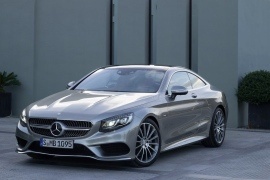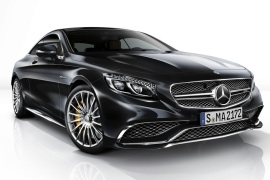MERCEDES BENZ S-Class Coupe AMG Models/Series Timeline, Specifications & Photos
First production year: 2014
Engines: Gasoline
Body style: Coupé (two-door)
Mercedes-Benz introduced the most powerful version of the S-Class coupe on the market in 2014 and proved to the world, once again, that when the three-pointed star is pushed and helped by its AMG sub-brand, it can provide an extremely luxurious and fast vehicle.
Mercedes-Benz has always produced luxurious, two-door vehicles for those who enjoy driving comfortable cars over long distances, and the S-Class coupe was not an exception. There were several generations of this luxo-barge that thrilled its customers, but only the AMG versions could threaten the supremacy of other German sportscars. So, the 2014 Mercedes-Benz came to confirm that with a shortened version of the S-Class, fewer doors but improved handling and power.
The grand-touring lines of the S-Class coupe were available with other engine versions, but only the AMG had a few specific details that made it different from its siblings. At the front, the S 63 Coupe featured LED headlights adorned with Swarovski crystals implanted inside the headlamps at their upper side. The car manufacturer went even further and mounted an AMG-specific grille adorned with chromed dots and a horizontal slat that resembled a wing. In addition, on the lower side of the bumper, AMG installed an aggressive-looking bumper with an A-shaped center intake flanked by a pair of side scoops that cooled the front brakes. From its profile, the lines that went on the bodywork from the front wheel arches to the rear quarter panels created a dynamic yet elegant image for the vehicle. Finally, at the back, there was a small integrated spoiler into the trunk lid, while underneath the bumper, the automaker installed two wide, rectangular-shaped exhausts that flanked the rear diffuser.
Inside, the S 63 boasted a very high level of luxury. The leather-wrapped cabin featured four heated seats, and the front ones could've been ordered with high-bolstered, adjustable areas. Moreover, the automaker even installed vents that blew warm air onto occupants' necks, similar to those existing in the SL-Class. These were useful when the driver chose to lower all four windows. The dashboard was a mix of art, luxury, and technology. For starters, fronting the driver was a digital display that showed all the necessary information to the driver. Next to that, atop the center stack, was an additional LCD for the infotainment system. Between the front occupants, the automaker placed a tall center console with a storage compartment. The console also housed the settings for the transmission, suspension, and driving modes. In the back, the automaker installed a bench seat profiled for two, but with less legroom left due to the size of the front seats. But those were fine for short and medium travels.
Under the skin, the 5.5-liter biturbo AMG engine was not just very powerful but also smooth. It sent 577 HP (585 PS) to the rear wheels via a seven-speed automatic transmission tuned by AMG. Even though the automaker offered other versions of the S-Coupe with all-wheel-drive systems, the S 63 AMG was RWD only.
Mercedes-Benz threw its gloves off when it made the S65 AMG coupe and launched it on the market in 2014, continuing a long range of high-performance luxury coupes.
In late 2013, Mercedes-Benz stormed the Frankfurt International Motor Show floors when it unveiled the concept version of the S-Class coupe, testing reactions for a production model. People reacted positively, and as a result, in March 2014, at the Geneva Motor Show, the German automaker unveiled the final product. Starting in September of the same year, the three-pointed star brand released two AMG versions: the S63 and the S65. While a turbocharged V8 powered the former, the latter featured a mighty turbocharged V12.
The S-Class coupe was already known as a luxurious personal vehicle fit for long-distance runs, but the car didn’t impress in terms of aggressiveness. AMG tried to fix that and installed its known A-shaped lower grille on the air dam flanked by a pair of scoops. All these details were covered with a chicken-grille-style mesh. At the same time, the upper grille featured the same pattern but with a double-slat trim in the middle that supported the three-pointed star badge. The headlights featured LEDs for the daytime running lights, which looked like pearls. On the sides, the V12 TWINTURBO badges mounted on the front fenders warned bystanders that this was no ordinary vehicle. It wasn’t just another GT; it was a faster one.
Inside, Mercedes-Benz threw every luxury item it had in its baskets when it made the car. There was a completely digital display for the instrument cluster and the infotainment system that sat atop the dashboard, covered by a visor to protect it from the sun. The seats featured massage and inflatable areas to keep their occupants in place. In the back, the bench seat was wide enough for three but profiled for two, with a massive center console between them. A superior entertainment system with 24 speakers indulged the cabin’s occupants with a high-quality sound.
But the S65 AMG was more than just a luxo-barge; it was mean and powerful. In fact, the twin-turbo V12 under the hood provided so much torque that the automaker had no other choice than to pair it with an AMG-tuned seven-speed automatic gearbox (AMG Speedshift) and rear-wheel drive only. Its less-powered sibling, the S63, was available with an all-wheel-drive system. But the massive 1000 Nm (738 lb-ft.) of torque was just too much for front shafts. Still, AMG tweaked not just the powertrain but also the intelligent suspension system, enhancing Mercedes’ Active Body Control (ABC) unit. This system “read” the road through two cameras on the windshield and adapted the dampers accordingly to compensate for bumps and potholes. In the AMG version, the same system let the massive, 2.2-ton (4,817 lbs) vehicle lean into the curve like a motorcyclist, albeit not at the same angle. As a result, the only body roll felt by those inside the vehicle was caused by the low-profile tires, so it was minimal.

